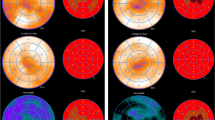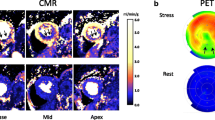Abstract
Objectives
Despite advances in non-invasive myocardial perfusion imaging (MPI) evaluation, computed tomography (CT) multiphase MPI protocols have not yet been compared with the highly accurate rubidium-82 positron emission tomography (82RbPET) MPI. Thus, this study aimed to evaluate agreement between 82RbPET and 320-detector row CT (320-CT) MPI using a multiphase protocol in suspected CAD patients.
Methods
Forty-four patients referred for MPI evaluation were prospectively enrolled and underwent dipyridamole stress 82RbPET and multiphase 320-CT MPI (five consecutive volumetric acquisitions during stress). Statistical analyses were performed using the R software.
Results
There was high agreement for recognizing summed stress scores ≥ 4 (kappa 0.77, 95% CI 0.55–0.98, p < 0.001) and moderate for detecting SDS ≥ 2 (kappa 0.51, 95% CI 0.23–0.80, p < 0.001). In a per segment analysis, agreement was high for the presence of perfusion defects during stress and rest (kappa 0.75 and 0.82, respectively) and was moderate for impairment severity (kappa 0.58 and 0.65, respectively). The 320-CT protocol was safe, with low radiation burden (9.3 ± 2.4 mSv).
Conclusions
There was a significant agreement between dipyridamole stress 320-CT MPI and 82RbPET MPI in the evaluation of suspected CAD patients of intermediate risk. The multiphase 320-CT MPI protocol was feasible, diagnostic and with relatively low radiation exposure.
Key Points
• Rubidium-82 PET and 320-MDCT can perform MPI studies for CAD investigation.
• There is high agreement between rubidium-82 PET and 320-MDCT for MPI assessment.
• Multiphase CT perfusion protocols are feasible and with low radiation.
• Multiphase CT perfusion protocols can identify image artefacts.






Similar content being viewed by others
Abbreviations
- %MI:
-
Percentage myocardium ischaemia
- 320-CT:
-
320-detector row MDCT
- CAD:
-
Coronary artery disease
- CS:
-
Coronary calcium score
- CT:
-
Computed tomography
- CTA:
-
Coronary computed tomography angiography
- CTP:
-
Computed tomography myocardial perfusion
- Cx:
-
Circumflex coronary artery
- ECG:
-
Electrocardiogram
- ERD:
-
Effective radiation dose
- FFR:
-
Fractional flow reserve
- ICA:
-
Invasive coronary angiography
- LAD:
-
Left anterior descending coronary artery
- MDCT:
-
Multi-detector row computed tomography
- MPI:
-
Myocardial perfusion imaging
- 82RbPET:
-
Rubidium-82 positron emission tomography
- RCA:
-
Right coronary artery
- SDS:
-
Summed difference score
- SPECT:
-
Single photon emission computed tomography
- SRS:
-
Summed rest score
- SSS:
-
Summed stress score
References
Douglas PS, Hoffmann U, Patel MR et al (2015) Outcomes of anatomical versus functional testing for coronary artery disease. N Engl J Med 372:1291–1300
Cremer P, Hachamovitch R, Tamarappoo B (2014) Clinical decision making with myocardial perfusion imaging in patients with known or suspected coronary artery disease. Semin Nucl Med 44:320–329
Mc Ardle BA, Dowsley TF, deKemp RA et al (2012) Does rubidium-82 PET have superior accuracy to SPECT perfusion imaging for the diagnosis of obstructive coronary disease?: A systematic review and meta-analysis. J Am Coll Cardiol 60:1828–1837
Miller JM, Rochitte CE, Dewey M et al (2008) Diagnostic performance of coronary angiography by 64-row CT. N Engl J Med 359:2324–2336
Arbab-Zadeh A, Hoe J (2011) Quantification of coronary arterial stenoses by multidetector CT angiography in comparison with conventional angiography methods, caveats, and implications. JACC Cardiovasc Imaging 4:191–202
George RT, Arbab-Zadeh A, Miller JM et al (2009) Adenosine stress 64- and 256-row detector computed tomography angiography and perfusion imaging: a pilot study evaluating the transmural extent of perfusion abnormalities to predict atherosclerosis causing myocardial ischemia. Circ Cardiovasc Imaging 2:174–182
Rochitte CE, George RT, Chen MY et al (2014) Computed tomography angiography and perfusion to assess coronary artery stenosis causing perfusion defects by single photon emission computed tomography: the CORE320 study. Eur Heart J 35:1120–1130
Williams MC, Weir NW, Mirsadraee S et al (2013) Iterative reconstruction and individualized automatic tube current selection reduce radiation dose while maintaining image quality in 320-multidetector computed tomography coronary angiography. Clin Radiol 68:e570–e577
Ziemer BP, Hubbard L, Lipinski J, Molloi S (2015) Dynamic CT perfusion measurement in a cardiac phantom. Int J Card Imaging 31:1451–1459
Danad I, Szymonifka J, Schulman-Marcus J, Min JK (2016) Static and dynamic assessment of myocardial perfusion by computed tomography. Eur Hear J Cardiovasc Imaging 17:836–844
Agatston AS, Janowitz WR, Hildner FJ et al (1990) Quantification of coronary artery calcium using ultrafast computed tomography. J Am Coll Cardiol 15:827–832
Halliburton SS, Abbara S, Chen MY et al (2011) SCCT guidelines on radiation dose and dose-optimization strategies in cardiovascular CT. J Cardiovasc Comput Tomogr 5:198–224
Cerqueira MD, Weissman NJ, Dilsizian V et al (2002) Standardized myocardial segmentation and nomenclature for tomographic imaging of the heart. A statementfor healthcare professionals from the Cardiac Imaging Committee of the Council on Clinical Cardiology of the American Heart Association. Circulation 105:539–42
Yoshinaga K, Chow BJ, Williams K et al (2006) What is the prognostic value of myocardial perfusion imaging using rubidium-82 positron emission tomography? J Am Coll Cardiol 48:1029–1039
Dorbala S, Di Carli MF (2014) Cardiac PET perfusion: prognosis, risk stratification, and clinical management. Semin Nucl Med 44:344–357
Cury RC, Magalhães TA, Borges AC et al (2010) Dipyridamole stress and rest myocardial perfusion by 64-detector row computed tomography in patients with suspected coronary artery disease. Am J Cardiol 106:310–315
George RT, Arbab-Zadeh A, Cerci RJ et al (2011) Diagnostic performance of combined noninvasive coronary angiography and myocardial perfusion imaging using 320-MDCT: the CT angiography and perfusion methods of the CORE320 multicenter multinational diagnostic study. AJR Am J Roentgenol 197:829–837
Hachamovitch R, Hayes SW, Friedman JD et al (2004) Stress myocardial perfusion single-photon emission computed tomography is clinically effective and cost effective in risk stratification of patients with a high likelihood of coronary artery disease (CAD) but no known CAD. J Am Coll Cardiol 43:200–208
Dorbala S, Di Carli MF, Beanlands RS et al (2013) Prognostic value of stress myocardial perfusion positron emission tomography: results from a multicenter observational registry. J Am Coll Cardiol 61:176–184
Chen A, Wang H, Fan B et al (2017) Prognostic value of normal positron emission tomography myocardial perfusion imaging in patients with known or suspected coronary artery disease: a meta-analysis. Br J Radiol 90:20160702
Kikuchi Y, Oyama-Manabe N, Naya M et al (2014) Quantification of myocardial blood flow using dynamic 320-row multi-detector CT as compared with 15O-H2O PET. Eur Radiol 24:1547–1556
Klein R, Beanlands RSB, deKemp RA (2010) Quantification of myocardial blood flow and flow reserve: technical aspects. J Nucl Cardiol 17:555–570
Qayyum AA, Kühl JT, Kjaer A et al (2015) Semi-quantitative myocardial perfusion measured by computed tomography in patients with refractory angina: a head-to-head comparison with quantitative rubidium-82 positron emission tomography as reference. Clin Physiol Funct Imaging. https://doi.org/10.1111/cpf.12322
Bischoff B, Bamberg F, Marcus R et al (2013) Optimal timing for first-pass stress CT myocardial perfusion imaging. Int J Card Imaging 29:435–442
Koepfli P, Wyss CA, Namdar M et al (2004) Beta-adrenergic blockade and myocardial perfusion in coronary artery disease: differential effects in stenotic versus remote myocardial segments. J Nucl Med 45:1626–1631
Rybicki FJ, Mather RT, Kumamaru KK et al (2015) Comprehensive assessment of radiation dose estimates for the CORE320 study. AJR Am J Roentgenol 204:W27–W36
Hoffmann U, Ferencik M, Udelson JE et al (2017) Prognostic value of noninvasive cardiovascular testing in patients with stable chest pain: insights from the PROMISE Trial (Prospective Multicenter Imaging Study for Evaluation of Chest Pain). Circulation 135:2320–2332
Feinstein AR, Cicchetti DV (1990) High agreement but low kappa: I. the problems of two paradoxes. J Clin Epidemiol 43:543–549
Funding
This study has received funding by São Paulo Research Foundation (Fundação de Amparo à Pesquisa do Estado de São Paulo - FAPESP) - research grant number 2010/ 51100-7.
Author information
Authors and Affiliations
Corresponding author
Ethics declarations
Guarantor
The scientific guarantor of this publication is Jose Rodrigues Parga.
Conflict of interest
The authors of this manuscript declare no relationships with any companies whose products or services may be related to the subject matter of the article.
Statistics and biometry
Marcio Augusto Diniz kindly provided statistical advice for this manuscript.
One of the authors has significant statistical expertise (Antonildes N. Assuncao).
Informed consent
Written informed consent was obtained from all subjects (patients) in this study.
Ethical approval
Institutional review board approval was obtained.
Methodology
• Prospective
• Diagnostic or prognostic study
• Performed at one institution
Rights and permissions
About this article
Cite this article
Dantas, R.N., Assuncao, A.N., Marques, I.A. et al. Myocardial perfusion in patients with suspected coronary artery disease: comparison between 320-MDCT and rubidium-82 PET. Eur Radiol 28, 2665–2674 (2018). https://doi.org/10.1007/s00330-017-5257-2
Received:
Revised:
Accepted:
Published:
Issue Date:
DOI: https://doi.org/10.1007/s00330-017-5257-2




